The contribution of hydrophobic residues in the pore-forming region of the ryanodine receptor channel to block by large tetraalkylammonium cations and Shaker B inactivation peptides
- PMID: 22930804
- PMCID: PMC3434103
- DOI: 10.1085/jgp.201210851
The contribution of hydrophobic residues in the pore-forming region of the ryanodine receptor channel to block by large tetraalkylammonium cations and Shaker B inactivation peptides
Abstract
Although no high-resolution structural information is available for the ryanodine receptor (RyR) channel pore-forming region (PFR), molecular modeling has revealed broad structural similarities between this region and the equivalent region of K(+) channels. This study predicts that, as is the case in K(+) channels, RyR has a cytosolic vestibule lined with predominantly hydrophobic residues of transmembrane helices (TM10). In K(+) channels, this vestibule is the binding site for blocking tetraalkylammonium (TAA) cations and Shaker B inactivation peptides (ShBPs), which are stabilized by hydrophobic interactions involving specific residues of the lining helices. We have tested the hypothesis that the cytosolic vestibule of RyR fulfils a similar role and that TAAs and ShBPs are stabilized by hydrophobic interactions with residues of TM10. Both TAAs and ShBPs block RyR from the cytosolic side of the channel. By varying the composition of TAAs and ShBPs, we demonstrate that the affinity of both species is determined by their hydrophobicity, with variations reflecting alterations in the dissociation rate of the bound blockers. We investigated the role of TM10 residues of RyR by monitoring block by TAAs and ShBPs in channels in which the hydrophobicity of individual TM10 residues was lowered by alanine substitution. Although substitutions changed the kinetics of TAA interaction, they produced no significant changes in ShBP kinetics, indicating the absence of specific hydrophobic sites of interactions between RyR and these peptides. Our investigations (a) provide significant new information on both the mechanisms and structural components of the RyR PFR involved in block by TAAs and ShBPs, (b) highlight important differences in the mechanisms and structures determining TAA and ShBP block in RyR and K(+) channels, and (c) demonstrate that although the PFRs of these channels contain analogous structural components, significant differences in structure determine the distinct ion-handling properties of the two species of channel.
Figures
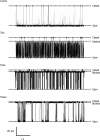


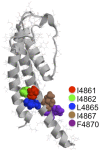
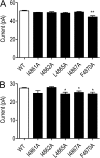




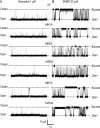
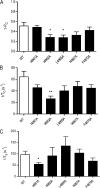
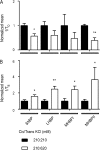
Similar articles
-
Investigations of the contribution of a putative glycine hinge to ryanodine receptor channel gating.J Biol Chem. 2013 Jun 7;288(23):16671-16679. doi: 10.1074/jbc.M113.465310. Epub 2013 Apr 30. J Biol Chem. 2013. PMID: 23632022 Free PMC article.
-
Light at the end of the Ca(2+)-release channel tunnel: structures and mechanisms involved in ion translocation in ryanodine receptor channels.Q Rev Biophys. 2001 Feb;34(1):61-104. doi: 10.1017/s0033583501003675. Q Rev Biophys. 2001. PMID: 11388090 Review.
-
The predicted TM10 transmembrane sequence of the cardiac Ca2+ release channel (ryanodine receptor) is crucial for channel activation and gating.J Biol Chem. 2004 Jan 30;279(5):3635-42. doi: 10.1074/jbc.M311367200. Epub 2003 Oct 30. J Biol Chem. 2004. PMID: 14593104
-
Functional characterization of the cardiac ryanodine receptor pore-forming region.PLoS One. 2013 Jun 12;8(6):e66542. doi: 10.1371/journal.pone.0066542. Print 2013. PLoS One. 2013. PMID: 23776685 Free PMC article.
-
Membrane topology and membrane retention of the ryanodine receptor calcium release channel.Cell Biochem Biophys. 2004;40(2):207-24. doi: 10.1385/CBB:40:2:207. Cell Biochem Biophys. 2004. PMID: 15054223 Review.
Cited by
-
Unambiguous observation of blocked states reveals altered, blocker-induced, cardiac ryanodine receptor gating.Sci Rep. 2016 Oct 5;6:34452. doi: 10.1038/srep34452. Sci Rep. 2016. PMID: 27703263 Free PMC article.
-
Insights into the gating mechanism of the ryanodine-modified human cardiac Ca2+-release channel (ryanodine receptor 2).Mol Pharmacol. 2014 Sep;86(3):318-29. doi: 10.1124/mol.114.093757. Epub 2014 Jul 7. Mol Pharmacol. 2014. PMID: 25002270 Free PMC article.
-
Investigations of the contribution of a putative glycine hinge to ryanodine receptor channel gating.J Biol Chem. 2013 Jun 7;288(23):16671-16679. doi: 10.1074/jbc.M113.465310. Epub 2013 Apr 30. J Biol Chem. 2013. PMID: 23632022 Free PMC article.
-
Effect of flecainide derivatives on sarcoplasmic reticulum calcium release suggests a lack of direct action on the cardiac ryanodine receptor.Br J Pharmacol. 2016 Aug;173(15):2446-59. doi: 10.1111/bph.13521. Epub 2016 Jun 29. Br J Pharmacol. 2016. PMID: 27237957 Free PMC article.
-
Arrhythmogenesis in a catecholaminergic polymorphic ventricular tachycardia mutation that depresses ryanodine receptor function.Proc Natl Acad Sci U S A. 2015 Mar 31;112(13):E1669-77. doi: 10.1073/pnas.1419795112. Epub 2015 Mar 16. Proc Natl Acad Sci U S A. 2015. PMID: 25775566 Free PMC article.
References
Publication types
MeSH terms
Substances
Grants and funding
LinkOut - more resources
Full Text Sources

